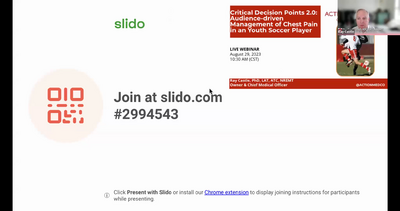Course Info (Learning Objectives; Clinical Bottom Line; Summary Conclusions)
BOC Domains of Athletic Training:
-
Domain I - Risk Reduction, Wellness, and Health Literacy
-
Domain II - Clinical Evaluation and Diagnosis
-
Domain Ill - Critical Incident Management
-
Domain V - Healthcare Administration and Professional Responsibility
Upon completion of this course, participants will be able to:
- Identify appropriate initial care steps and interventions for a pediatric soccer athlete experiencing acute chest pain.
- Apply effective decision-making skills when faced with acute chest pain in an athletic setting.
- Enhance critical thinking abilities in evaluating potential causes of chest pain in athletes.
- Analyze and interpret a detailed case study summary to reinforce knowledge and understanding.
- Recognize and implement best practices and emergency care protocols for possible cardiac events in athletes.
Clinical Bottom Line:
The session emphasizes the critical importance of early activation of EMS for cardiac care in cases of acute chest pain. It addresses incident rates for commotio cordis and other cardiac events in the pediatric athlete population, highlighting the need for heightened awareness and preparedness. The session also underscores the significance of having appropriate emergency care equipment readily available for athletic trainers to ensure prompt and effective interventions. By reviewing best practices and emergency care protocols, this session equips athletic trainers and other professionals with the necessary knowledge and skills to confidently manage cardiac events. The clinical bottom line reinforces the essential steps of early EMS activation, understanding incident rates, ensuring equipment availability, and implementing best practices to optimize emergency care for athletes experiencing acute chest pain.
Summary Conclusions:
- Through dynamic discussions and a realistic case scenario, participants actively make crucial decisions for the well-being of athletes experiencing acute chest pain.
- The session enhances critical thinking skills, deepens comprehension of potential causes of chest pain in athletes, and emphasizes effective decision-making, ultimately leading to the identification of commotio cordis with ventricular tachycardia as the final diagnosis.
- A comprehensive case study summary exemplifies the practical application of decision-making and reinforces knowledge gained, specifically highlighting the unique challenges and appropriate interventions for commotio cordis in athletes.
- By reviewing best practices and emergency care protocols, the session ensures that athletic trainers and other professionals are well-prepared to handle cardiac events, addressing the clinical practice gap in acute chest pain management for athletes, particularly in cases of commotio cordis with ventricular tachycardia.

